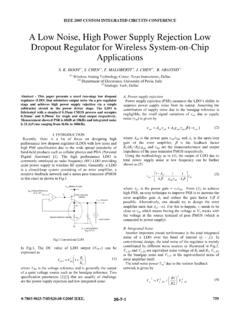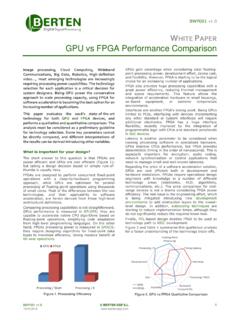Transcription of FPGA Logic Cells Comparison - Sharif
1 FPGA Logic Cells Comparison In this article we compare Logic Cells architectures that are used in modern fpgas : Xilinx (both Virtex-5 and earlier), Altera and Actel. Introduction FPGA ( field programmable gate array ) is an integrated circuit containing a matrix of user- programmable Logic Cells , being able to implement complex digital circuitry. These gates are designed to implement user-defined combinational and sequential functions. FPGA. families from different vendors use different Logic Cells architecture. Below you can find a short overview of different FPGA Logic Cells architectures, as well as an attempt to elaborate a universal method of their Comparison . Xilinx Slices (Virtex-4 and earlier). The elementary programmable Logic block in Xilinx fpgas is called slice. This architecture (with minor modifications) is used in all Virtex FPGA families before Virtex-5 and all Spartan FPGA families so far (at least, up to Spartan-3A).
2 The Virtex-4 FPGA slice includes: Two 4-input LUTs (Look-Up Tables) that can implement any 4-input boolean function, used as combinational function generators (one LUT is marked F , the other one is marked G ). Two dedicated user-controlled multiplexers for combinational Logic (MUXF5 and MUXFX). MUXF5 can be used to combine outputs of the slice's LUTs and so to implement 5-input combinational circuit. MUXFX is used to combine outputs of the other MUXF5 and MUXFX (from the other slices). Dedicated arithmetic Logic (two 1-bit adders, carry chain and two dedicated AND gates for fast and efficient multiplication). Two 1-bit registers that can be configured either as flip-flops or as latches. The input to these registers is selected by YMUX and XMUX multiplexers. Note that these multiplexers aren't user-controlled: the path is selected during FPGA programming. The simplified diagram of a Virtex-4 slice is presented below.
3 MUXFX. D Q. 4-input LUT. CE. (G) YMUX. Arithmetic CLK. MUXF5. and carry SR. Logic D Q. 4-input LUT. CE. (F) XMUX. CLK. SR. Fig. 1: A simplified diagram of a Xilinx Virtex-4 FPGA slice This 4-input LUT-based architecture became can be considered classic. To implement a a 4-input LUT one need 16 bits of memory. Then, we can measure an amount of combinational Logic that can be fitted in the slice by calculating the total number of LUT bits. Xilinx Virtex-4 slice Combinational Logic density (in LUT bits) 32. Register bits 2. Xilinx Virtex-5 Slices The Virtex-5 slices include: Four LUTs (Look-Up Tables) that can be configured as 6-input LUTs with 1-bit output or 5- input LUTs with 2-bit output. Three dedicated user-controlled multiplexers for combinational Logic (F7 AMUX, F7 BMUX. and F8 MUX). F7 AMUX and F7 BMUX combine outputs of the slice's LUTs to implement 7-input combinational circuits. F8 MUX is used to combine outputs of the F7 AMUX and F7 BMUX.
4 Dedicated arithmetic Logic (two 1-bit adders and a carry chain). Four 1-bit registers that can be configured either as flip-flops or as latches. The input to these registers is selected by AMUX DMUX multiplexers. Note that these multiplexers aren't user-controlled: the path is selected during FPGA programming. The main differences from the previous architecture: Configurable 6-to-1 or 5-to-2 LUTs instead of 4-to-1 LUTs. 4 LUTs and 4 register bits per slice. Dedicated arithmetic Logic circuitry doesn't include dedicated AND gate . LUT. DMUX D Q. F7 BMUX. CLK. CE. SR. LUT CMUX D Q. Arithmetic and CLK. F8 MUX carry Logic CE. SR. LUT BMUX D Q. F7 AMUX CLK. CE. SR. LUT AMUX D Q. CLK. CE. SR. Fig. 2: A simplified diagram of a Virtex-5 FPGA slice For example, it is possible in Virtex-5 to implement a full 4-to-1 multiplexer with just one LUT. Xilinx Virtex-5 slice Combinational Logic density (in LUT bits) 256.
5 Register bits 4. Altera ALMs Altera fpgas (Stratix and Cyclone families) uses slightly different Logic blocks called Adaptive Logic Modules (ALMs). ALM resources include: Two 4-input LUTs and four 3-input LUTs for combinational Logic implementation. Dedicated arithmetic and carry Logic . Two programmable registers. It should be noted that an ALM has only 8 inputs, which is less than a total number of LUT inputs. This means that some input signals are connected to more than one LUT. There are several input signal multiplexers in the ALM that forms a kind of interconnect matrix programmable by the user (at the time of configuration). Note that not every connection is possible. Refer to the Stratix-IV. Device Handbook for more details. 4-input LUT. 3- FF. input LUT. 3- input LUT. Interconnect Arithmetic and matrix carry Logic 4-input LUT. 3- input FF. LUT. 3- input LUT. Fig. 3: A simplified diagram of the Altera ALM.
6 Altera ALM. Combinational Logic density (in LUT bits) 64. Register bits 2. Actel VersaTile Actel produces fpgas mainly for aerospace and military applications. Compared with top Xilinx and Altera devices, Actel fpgas provide less Logic resources. The basic building block for Actel flash-based fpgas (such as ProASIC-3) is called VersaTile. Each VersaTile cell can implement any of the following: Any 3-input combinational Logic function, OR. D flip-flop or latch. One VersaTile can implement only one of these, not both. Therefore, for the purpose of our Comparison , we will divide LUT and register bits by 2. Actel VersaTile Combinational Logic density (in LUT bits) 4. Register bits Conclusion The architectures are very different, so it's difficult to compare them objectively. It should be understood that the results of such Comparison have limited application. It is usually the number of LUTs (and not the number of registers) that is a bottleneck for FPGA.
7 Designs. From this perspective, it could be stated that one Virtex-5 slice can in theory substitute 8. Virtex-4 slices or 4 ALM's. But in real-world designs it is impossible to utilize all the resources. Experiments with real-world designs show the following approximate relationship between different FPGA Logic blocks: Logic block Virtex-4 slices equivalent Xilinx Virtex-4 slice (reference) 1. Xilinx Virtex-5 slice 2. Altera ALM Actel VersaTile 1-CORE Technologies is a leading Russian electronics design company providing high-quality and cost-effective FPGA and ASIC design services. Address: 24 Radio str., Moscow, Russia, 105005. Tel.: +7 (495) 921-79-91. Web: E-mail.











